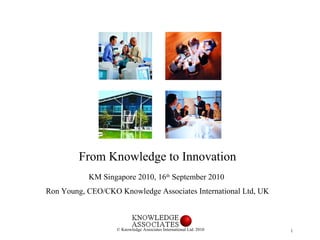I kms sep 2010 from knowledge to innovation
- 1. From Knowledge to Innovation KM Singapore 2010, 16 th September 2010 Ron Young, CEO/CKO Knowledge Associates International Ltd, UK
- 2. “ Our success depends on how well we exploit our most valuable assets: our knowledge, skills and creativity. These are key to designing high-value goods and services and advanced business practices. They are at the heart of a modern, knowledge driven economy.”
- 3. “ Government needs to learn and innovate as much as the private sector and it must create new mechanisms for sharing ideas and best practices.”
- 4. International Fund for Agricultural Development Enabling poor rural people to overcome poverty IFAD Innovation Strategy www.ifad.org
- 5. Knowledge Management & Innovation KM learning from past current good practices harmonization around proven practices communities marked by commonalities Innovation experimentation, prototyping good practices of tomorrow higher risk creativity deviance from established patterns diversity, crossing boundaries questioning established knowledge
- 7. “ Innovation is the useful application of new inventions and discoveries" Wikipedia
- 8. Organizational innovation 10% creators / innovators 20% enthusiasts 50% pragmatists 20% ludites
- 9. Participation Pyramid for web working Creators Critics & Collectors Couch potatoes
- 11. From Knowledge Management to Innovation
- 12. Left and Right Brain Hemispheres
- 13. Left and Right Brain Hemispheres HOW?
- 14. Left and Right Brain Hemispheres HOW? I’ll invent the how along the way
- 15. Left and Right Brain Hemispheres HOW? I’ll invent the how along the way I’ll believe it when I see it
- 16. Left and Right Brain Hemispheres HOW? I’ll invent the how along the way I’ll see it when I believe it I’ll believe it when I see it
- 17. Genius – Leonardo Da Vinci
- 18. Einstein
- 20. Nobody’s perfect…. ….but a TEAM can be Professor Belbin www.belbin.com
- 21. Critical Team Roles Plant Monitor Evaluator Co-ordinator Resource Investigator Implementer Completer Finisher Teamworkers Shapers Specialists
- 24. Key Competencies Knowledge Process Identifying Creating Storing Sharing Applying Innovation Process Capturing & generating Ideas Qualifying Developing Prototyping Testing Evaluating Implementing
- 25. Team Roles, Collaboration, Knowledge Flow, Knowledge and Innovation Competencies
- 26. Understanding the 4 Dimensions of Knowledge Management 1.Communication Stage 1 2. Collaboration Stage 2 3. KM Process Stage 3 4.Integration Stage 4
- 27. Understanding the 4 Dimensions of Knowledge Management & Innovation 1.Communication Stage 1 2. Collaboration Stage 2 3. KM Process Stage 3 4.Create & Innovate
- 28. KM & Innovation Strategy Sharing & Applying Knowledge Creativity Learning Innovation Collaborate Communicate
- 29. The Next Ten Years - Key Challenges To substantially increase the productivity of knowledge working, at least, 50 fold The exponential development of global knowledge sharing networks & relations Continuous radical knowledge creation and innovation To dramatically improve knowledge quality Leadership aligned to the timeless principles Applying the best knowledge strategies, tools and technologies
- 30. From Knowledge to Innovation KM Singapore 2010, 16 th September 2010 Ron Young, CEO/CKO Knowledge Associates International Ltd, UK
- 32. Contact Ron Young Web: www.knowledge-management-online.com Blog: http://km-consulting.blogspot.com Facebook: www.facebook.com/ronyoung Linkedin: www.linkedin.com/ronyoung Twitter: www.twitter.com/ronyoung Knols: knol.google.com/ronyoung Email: ronyoung@young-int.com
Editor's Notes
- Key Messages: Transition:
- Key Messages Keywords here are collectively and systematically. KM is about Creating, Sharing and applying Knowledge KM must be linked to the Business Objectives  Transition
- Key Messages Framework to help organisations to start envisioning how the KM strategy might be structured.     Transition We will look how we can do this in the next step – knowledge assessment.
- Key Messages Framework to help organisations to start envisioning how the KM strategy might be structured.     Transition We will look how we can do this in the next step – knowledge assessment.
- Key Messages AAR is one technique for capturing learnings and ideas. Systematically asks these questions before, during and after a project. Â Transition So what do we do with this new knowledge?
- Key Messages: Transition:
































